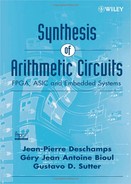8.2 OPERATIONS IN GF(p)
If p is a prime number, then Zp is the Galois field GF(p), and every nonzero element y of Zp has an inverse y−1. Unless p is small—in which case all inverses could have been previously computed and stored in a table—the computation of z = x−1 mod p is based on the extended Euclidean algorithm (Chapter 2, Section 2.1.2), which allows the expression of the greatest common divider of two natural numbers x and y in the form
![]()
where b and c are integers. Given x and p, the computation of z = x−1 mod p is made up of a sequence of integer divisions:

It has been demonstrated (Chapter 2, Section 2.1.2) that r(i) = b(i).p + c(i).x, so that
![]()
Taking into account that
![]()
and
![]()
after some finite number of steps, a remainder r(i + 2) is obtained such that
![]()
so
![]()
and
![]()
The corresponding algorithm is the following.
Algorithm 8.16 Inversion in Zp
r_i:=p; r_iplus1:=x; c_i:=0; c_iplus1:=1; while r_iplus1>1 loop q:=r_i/r_iplus1; r_iplus2:=r_i mod r_iplus1; c_iplus2:=(c_i-q*c_iplus1) mod p; r_i:=r_iplus1; r_iplus1:=r_iplus2; c_i:=c_iplus1; c_iplus1:=c_iplus2; end loop; z:=c_iplus1;
As a matter of fact, it can be demonstrated that − p/2 < c(i) < p/2 so that, in the preceding algorithm, it is not necessary to perform the mod p reduction at each step. The reduction can be performed at the end of the computation, substituting the last instruction by
if c_iplus1<0 then z:=c_iplus1+p; else z:=c_iplus1; end if;
Example 8.6 Compute the inverse of 114 mod 239:

